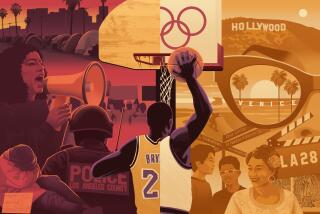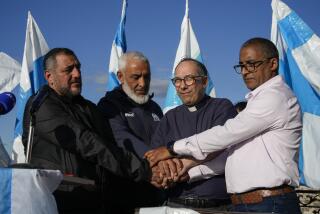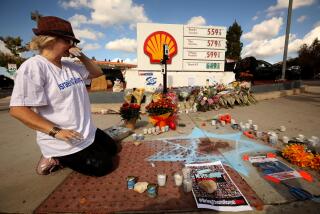An Undivided Jerusalem Rises Above Symbolism : Holy city: 25 years ago it was reunited, but the work continues to make it a community ofpeace for all faiths.
- Share via
The Psalmist’s admonition to “pray for the peace of Jerusalem” is as apt now, on the 25th anniversary of the holy city’s reunification, as it was three millennia ago.
There was little peace in Jerusalem in the 19 years before 1967, for the truce line established at the end of Israel’s War of Independence quickly hardened into a set of grotesque barriers that prefigured the Berlin Wall. The city was physically split by the “Green Line,” an obscene no-man’s land of barbed wire, tank traps, sniper posts and minefields. Jordanian occupation forces destroyed virtually every vestige of Jewish history in the historic Old City, including 58 synagogues; Jewish gravestones from the Mount of Olives were used to build roads and latrines for Jordanian troops.
Nor were the Jordanians very keen on the rights of pilgrims: Jews could not visit the Western Wall, and Israeli Muslims were denied access to the Dome of the Rock and the Al Aqsa mosque. During the Jordanian occupation, the Christian population of Jerusalem declined from 25,000 to 10,000.
Then, on the morning of June 7, 1967, Israel’s 55th Parachute Brigade, led by Col. Mordechai (Motta) Gur, stormed through St. Stephen’s Gate (or Lions’ Gate) on the northeast side of the old city walls and quickly established control over the Old City and its centerpiece, the Temple Mount. (There, they discovered that Jordanian troops had used the Temple Mount area, including the Dome of the Rock and the Al Aqsa mosque, as a huge ammunition dump, over the protests of the Jordanian civil governor. What might have happened if these piles of ammunition had exploded, destroying the Temple Mount and perhaps the nearby Church of the Holy Sepulcher, does not bear thinking.)
For the first time since Titus leveled the city in AD 70, Jewish control over the Western Wall--the surviving remnant of Herod’s Temple--was asserted. An exuberant paratrooper raised Israel’s flag over the Dome of the Rock; the flag was quickly removed on orders of Defense Minister Moshe Dayan.
Dayan’s gesture set an important pattern for the future. Shortly after the Six-Day War ended, in an action astonishing for a victorious power, senior officials of the government of Israel met with Arab leaders to assure them that the Muslim Waqf (a religious leadership council) would retain control of the Islamic holy places on the Temple Mount. With that crucial precedent established, and under the leadership of Mayor Teddy Kollek, reunified Jerusalem began to come alive again.
The open wound of the Green Line and its no-man’s-land was closed; a magnificent greenbelt now surrounds the Old City’s refurbished walls (raised in the 16th Century by Suleiman the Magnificent). The Jewish Quarter of the Old City was rebuilt. Free and open access to their holy places for people of all faiths was not merely proclaimed, it was implemented.
With funds raised by the indefatigable Kollek, the nonprofit Jerusalem Foundation spent hundreds of millions of dollars revitalizing the city’s parks, schools, museums and medical facilities (the most modern clinic in Jerusalem was opened several years ago in the Arab neighborhood of Sheikh Jarrah). Musical, artistic and literary festivals became a regular part of the rhythms of the city’s life. Kollek also created the Jerusalem Committee, an international and interreligious body of architects, artists, authors, lawyers and theologians, to advise the municipality on its urban planning.
The task that Kollek and his associates set for themselves was a daunting one: How could Jerusalem, an ancient symbol of humanity’s aspirations for redemption, become a living city that did not betray the promise of its name? That task remains incomplete 25 years after Jerusalem’s reunification. The Palestinian intifada has been relatively mild in Jerusalem, but terrorist attacks have taken a psychic as well as physical toll and have made the narrow streets of the Old City less attractive to residents and visitors alike.
The municipality’s commitment to maintaining the traditional balance among Jews, Christians and Muslims in the Old City has been challenged by ultra-Orthodox Jewish activists as well as Israeli government officials, including Housing Minister Ariel Sharon. The Christian leaders of Jerusalem remain divided among themselves; frightened by the intifada and carrying their own hoary grudges, they rarely acknowledge that their situation is far better now than in the 19 years of Jordanian rule.
Yet amid this seemingly endless divisiveness, the basic fact remains that Jerusalem has flourished since reunification. It is not what it ought to be. But it is so much better than it was, especially for religious pilgrims from around the world. And as the “question of Jerusalem” inevitably emerges in the current Middle East negotiations, the starting point for any serious reflection on the city’s future is this: Jerusalem must never again be divided.
More to Read
Sign up for Essential California
The most important California stories and recommendations in your inbox every morning.
You may occasionally receive promotional content from the Los Angeles Times.










